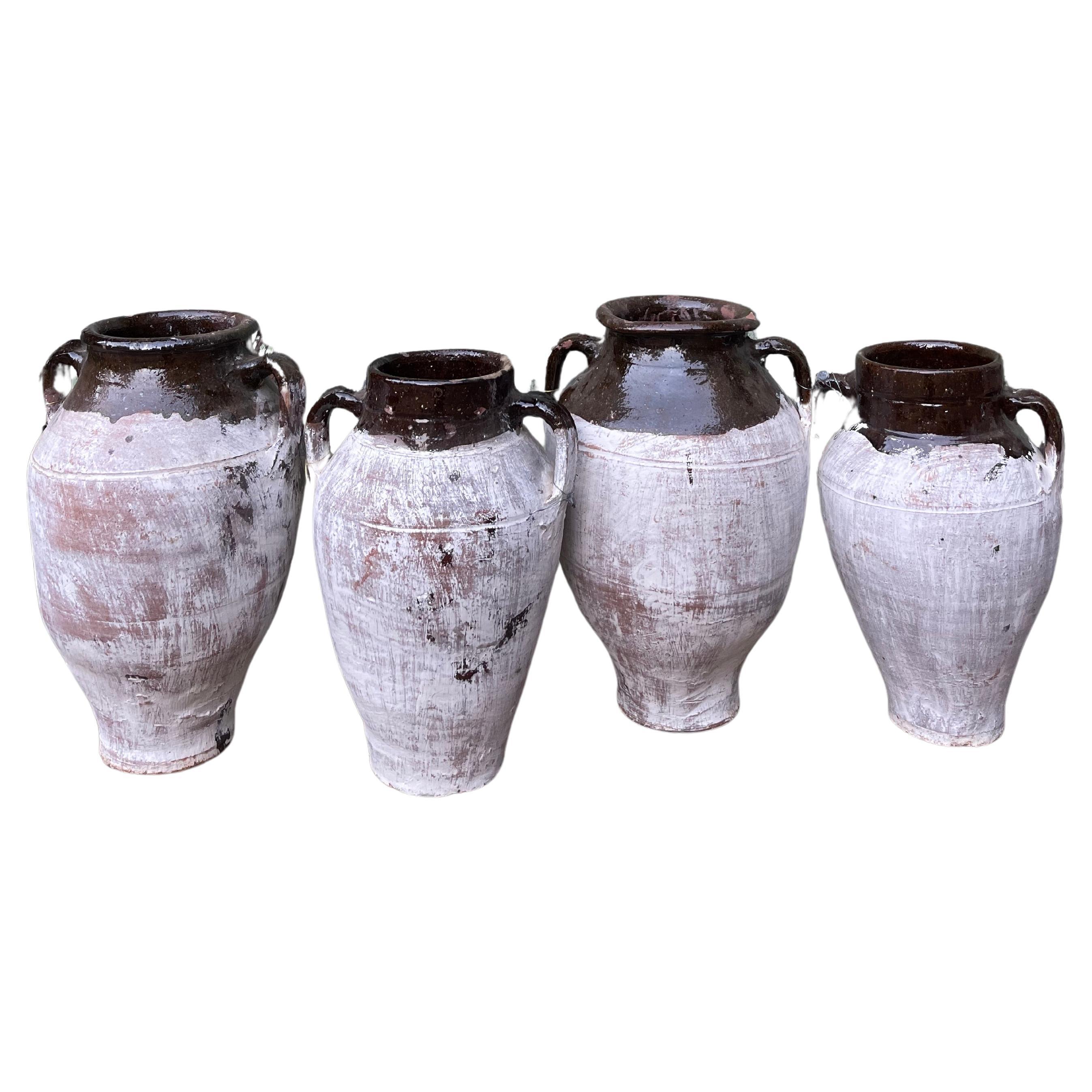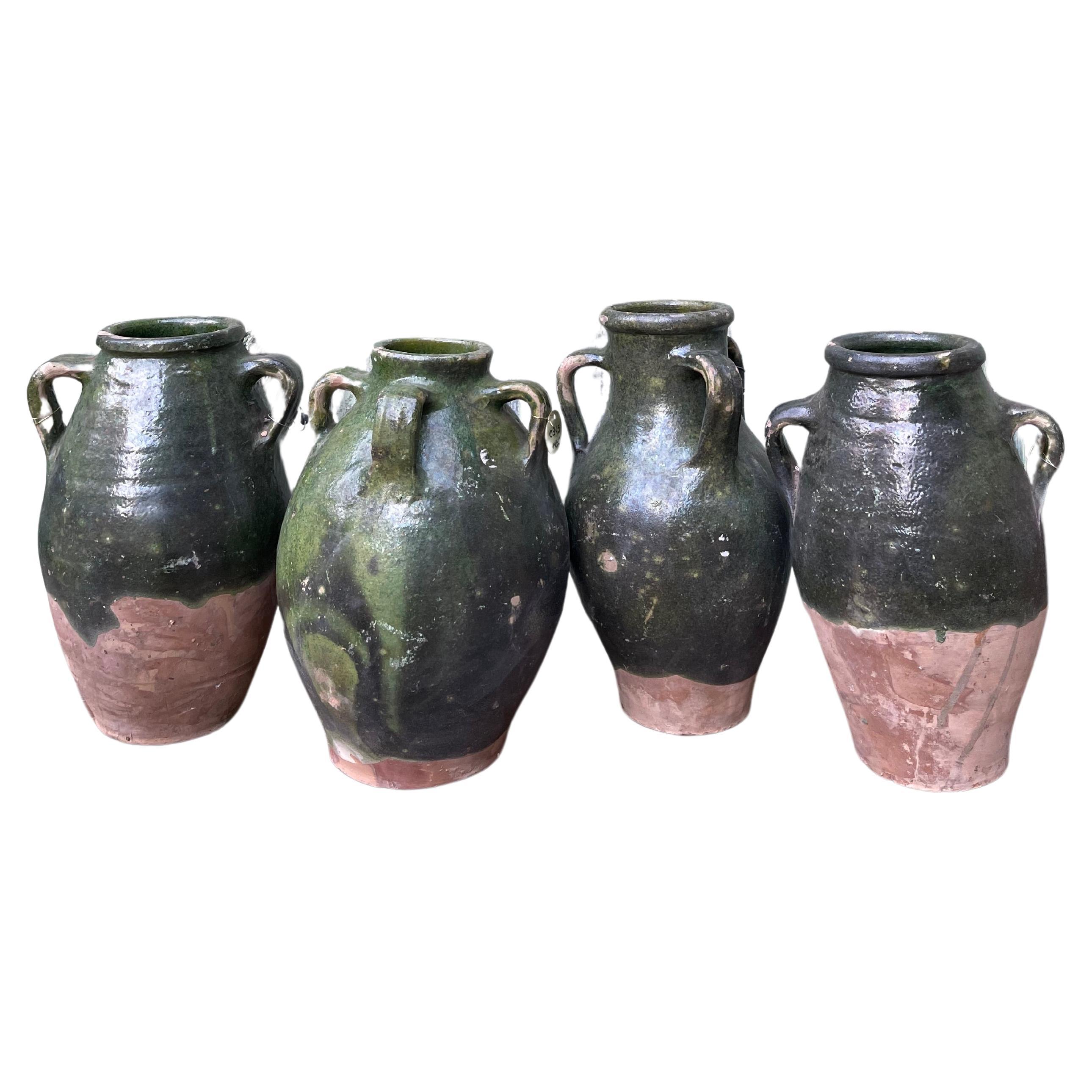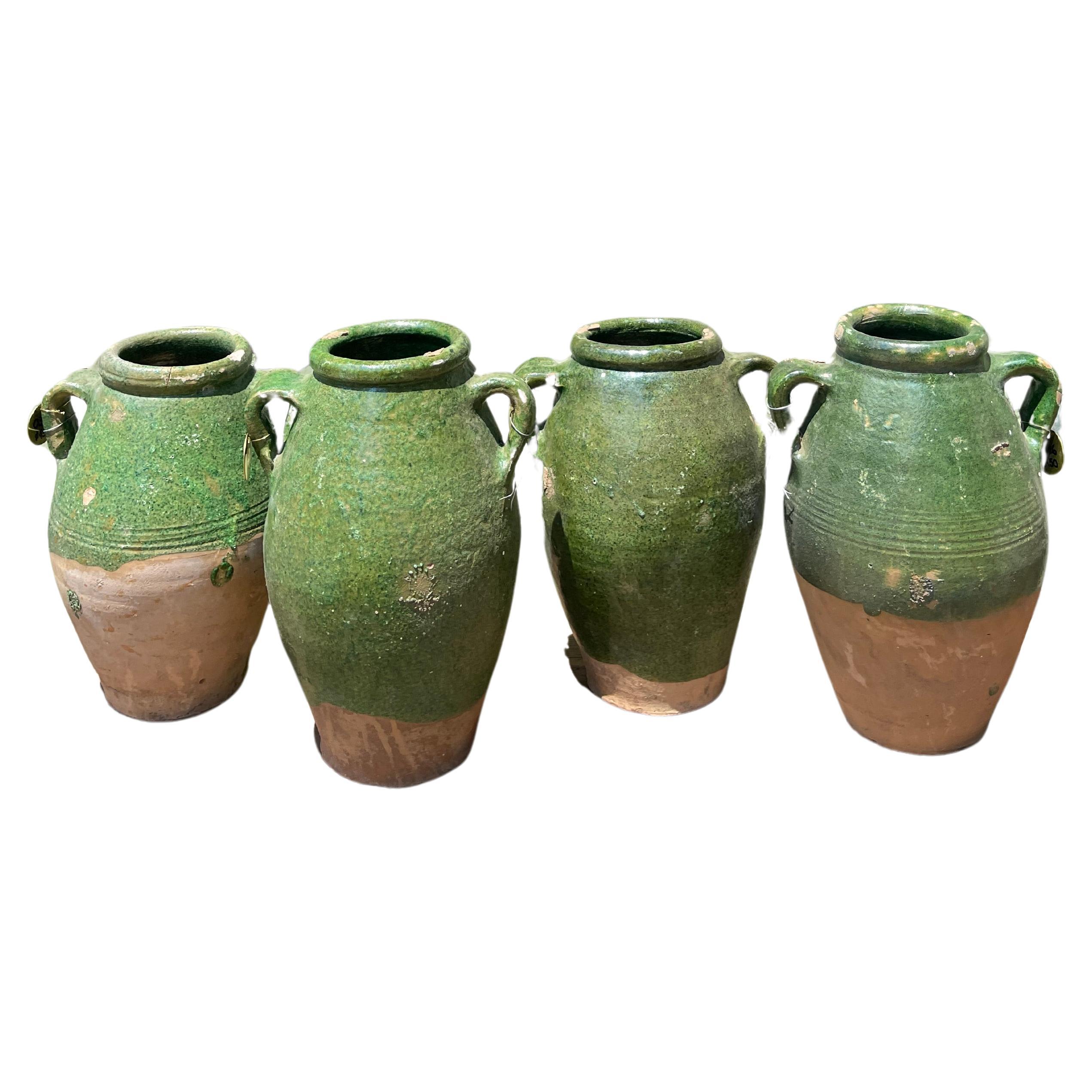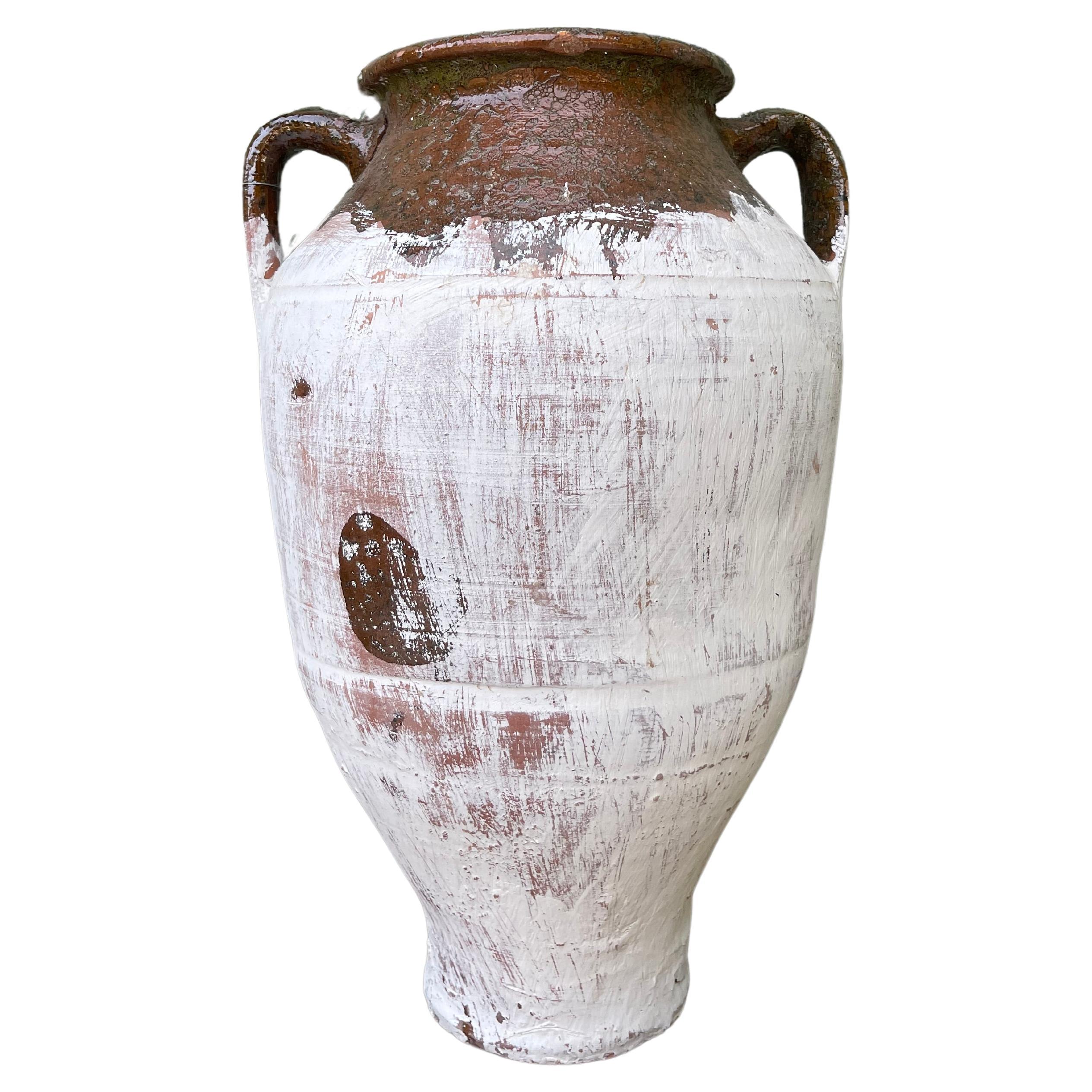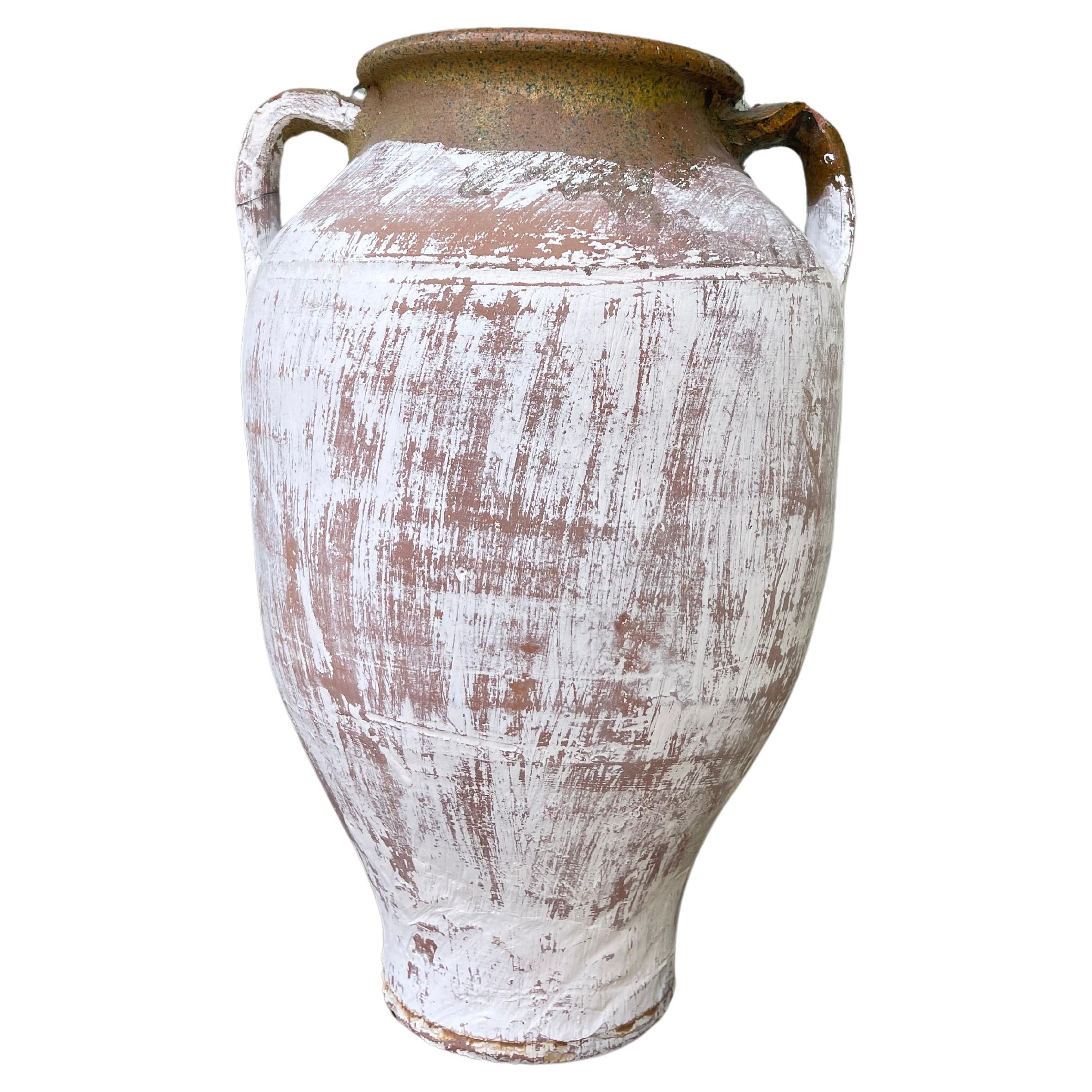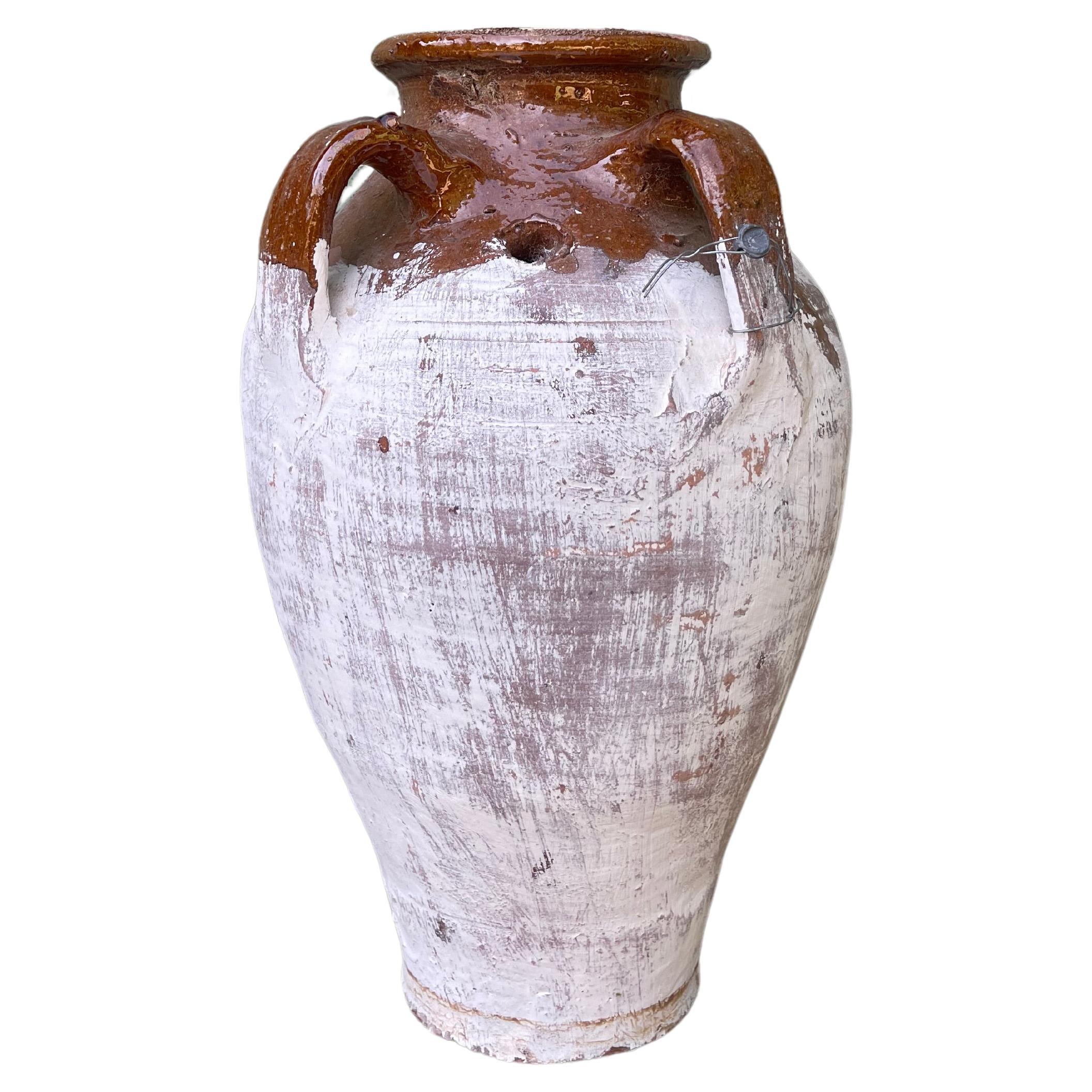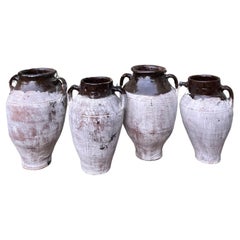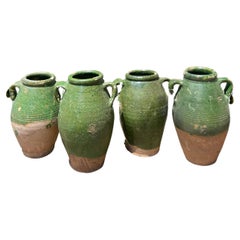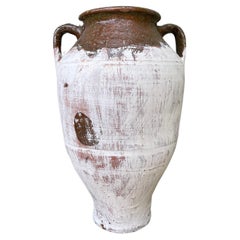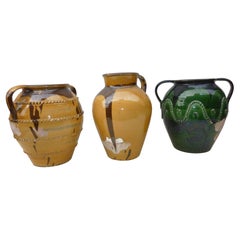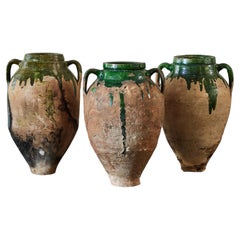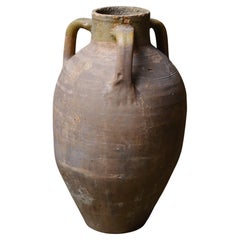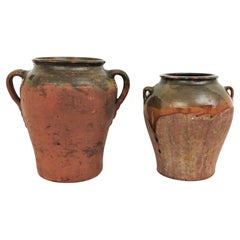Items Similar to Sırlı Küp (Turkish Glazed Jar - Medium) Set
Video Loading
Want more images or videos?
Request additional images or videos from the seller
1 of 12
Sırlı Küp (Turkish Glazed Jar - Medium) Set
$1,350per set
£1,021.74per set
€1,173.16per set
CA$1,923.19per set
A$2,085.74per set
CHF 1,095.51per set
MX$25,335.01per set
NOK 13,708.59per set
SEK 12,907.40per set
DKK 8,758.47per set
About the Item
This set of medium glazed and limewashed küps was likely used to store cheese by generations of families in the Levant. The design is similar to jugs used to carry water, wine, or other liquids (as cheese is traditionally stored in its brine). Glazing and lime-washing are techniques that has been used for centuries by Anatolian ceramicists to refresh, seal, and protect a clay vessel.
Cheese is a staple in most Turkish breakfasts today, with a fascinating history springing from the Fertile Crescent: the region of Southwest Asia that includes portions of present-day Turkey, Iraq, Iran, Jordan, Lebanon, and Syria. Around 8000 BCE, the first humans to keep livestock began firing pottery that could store dairy products in the warm climate. In this process, they discovered that they could use ceramic strainers to drain off the whey, creating cheese to enjoy fresh, to dry in the sun, or to salt & store.
One of the oldest urban centers of the world, Konya was the capital city of the Anatolian Seljuk Empire from 1060 until 1307. As the Anatolian Seljuks embellished their magnificent structures with colorful ceramic tiles, Konya became an esteemed global hub of ceramics (and remains so today). Rumi, the great 13th century Sufi poet, is buried in Konya.
*One-of-a-kind and marked by time, each of these pieces will show patina and natural imperfections. From oil stains to oxidation, we consider these alterations to be portals into a time long ago.
- Dimensions:Height: 16 in (40.64 cm)Diameter: 10 in (25.4 cm)
- Sold As:Set of 3
- Style:Greco Roman (In the Style Of)
- Materials and Techniques:
- Place of Origin:
- Period:
- Date of Manufacture:Unknown
- Condition:Minor fading.
- Seller Location:Ojai, US
- Reference Number:Seller: SKU's: 908+909+910 1stDibs: LU9865240608132
About the Seller
No Reviews Yet
Vetted Professional Seller
Every seller passes strict standards for authenticity and reliability
Established in 2023
1stDibs seller since 2024
10 sales on 1stDibs
Typical response time: 9 hours
- ShippingRetrieving quote...Shipping from: Ojai, US
- Return Policy
Authenticity Guarantee
In the unlikely event there’s an issue with an item’s authenticity, contact us within 1 year for a full refund. DetailsMoney-Back Guarantee
If your item is not as described, is damaged in transit, or does not arrive, contact us within 7 days for a full refund. Details24-Hour Cancellation
You have a 24-hour grace period in which to reconsider your purchase, with no questions asked.Vetted Professional Sellers
Our world-class sellers must adhere to strict standards for service and quality, maintaining the integrity of our listings.Price-Match Guarantee
If you find that a seller listed the same item for a lower price elsewhere, we’ll match it.Trusted Global Delivery
Our best-in-class carrier network provides specialized shipping options worldwide, including custom delivery.More From This Seller
View AllSırlı Küp (Turkish Glazed Jar - Medium) Set
Located in Ojai, US
This set of medium glazed küps was likely used for wine, water, goat's milk, or cheese by generations of families in the Levant. This traditional glazing technique, popular on Konya ...
Category
Mid-20th Century Turkish Greco Roman Jars
Materials
Ceramic, Terracotta
$1,900 / set
Sırlı Küp (Turkish Glazed Jar - Small) Set
Located in Ojai, US
This small "green-glazed" küp set was likely used for wine, water, goat's milk, or cheese by generations of families in the Levant. The phosphorescent green glaze, a traditional tech...
Category
Mid-20th Century Turkish Greco Roman Jars
Materials
Ceramic, Terracotta
$1,800 / set
Sırlı Küp (Turkish Glazed Jar - Small) Set
Located in Ojai, US
This small "green-glazed" küps set was likely used for wine, water, goat's milk, or cheese by generations of families in the Levant. The phosphorescent green glaze, a traditional tec...
Category
Mid-20th Century Turkish Greco Roman Jars
Materials
Ceramic, Terracotta
$1,800 / set
Sırlı Küp (Turkish Glazed Jar - Medium)
Located in Ojai, US
This medium glazed and limewashed küp was likely used to store cheese by generations of families in the Levant. The design is similar to jugs used to carry water, wine, or other liquids (as cheese is traditionally stored in its brine). Glazing and lime-washing are techniques that has been used for centuries by Anatolian ceramicists to refresh, seal, and protect a clay vessel.
Cheese is a staple in most Turkish breakfasts today, with a fascinating history springing from the Fertile Crescent: the region of Southwest Asia that includes portions of present-day Turkey, Iraq, Iran, Jordan, Lebanon, and Syria. Around 8000 BCE, the first humans to keep livestock began firing pottery that could store dairy products in the warm climate. In this process, they discovered that they could use ceramic strainers...
Category
Mid-20th Century Turkish Greco Roman Jars
Materials
Ceramic, Terracotta
Sırlı Küp (Turkish Glazed Jar - Medium)
Located in Ojai, US
This medium glazed and limewashed küp was likely used to store cheese by generations of families in the Levant. The design is similar to jugs used to carry water, wine, or other liquids (as cheese is traditionally stored in its brine). Glazing and lime-washing are techniques that has been used for centuries by Anatolian ceramicists to refresh, seal, and protect a clay vessel.
Cheese is a staple in most Turkish breakfasts today, with a fascinating history springing from the Fertile Crescent: the region of Southwest Asia that includes portions of present-day Turkey, Iraq, Iran, Jordan, Lebanon, and Syria. Around 8000 BCE, the first humans to keep livestock began firing pottery that could store dairy products in the warm climate. In this process, they discovered that they could use ceramic strainers...
Category
Mid-20th Century Turkish Greco Roman Jars
Materials
Ceramic, Terracotta
Sırlı Küp (Turkish Glazed Jar - Medium)
Located in Ojai, US
This medium glazed and limewashed küp was likely used to store cheese by generations of families in the Levant. The design is similar to jugs used to carry water, wine, or other liquids (as cheese is traditionally stored in its brine). Glazing and lime-washing are techniques that has been used for centuries by Anatolian ceramicists to refresh, seal, and protect a clay vessel.
Cheese is a staple in most Turkish breakfasts today, with a fascinating history springing from the Fertile Crescent: the region of Southwest Asia that includes portions of present-day Turkey, Iraq, Iran, Jordan, Lebanon, and Syria. Around 8000 BCE, the first humans to keep livestock began firing pottery that could store dairy products in the warm climate. In this process, they discovered that they could use ceramic strainers...
Category
Mid-20th Century Turkish Greco Roman Jars
Materials
Ceramic, Terracotta
You May Also Like
Italian Olive Jars from Puglia
Located in Los Angeles, CA
Italian Pottery from Puglia hand crafted
dimensions:
16 x 13.5 x 15 H
16 x 13.5 x 15 H
13 x 11 x 17 H
Category
Vintage 1960s Italian Primitive Jars
Materials
Clay
$1,350 / set
19th Century Bulgarian Terracotta Olive Oil Pots
Located in Los Angeles, CA
These early 20th-century Bulgarian terracotta olive oil pots exude rustic charm with their almond-like shapes and aged texture. Each pot features two sl...
Category
Early 20th Century Bulgarian Vases
Materials
Terracotta
$1,875 / item
20th Century Rustic Anatolian Double-Handled Terracotta Jar
Located in London, GB
An exceptional piece of 20th-century Anatolian craftsmanship, this Turkish amphora features a distinctive triple-handled design that reflects its utili...
Category
Vintage 1940s Turkish Rustic Jars
Materials
Clay
Two Spanish Terracotta Olive Jars or Vessels
Located in Barcelona, ES
Handmade terracotta preserving pot or jar with handles from Segovia, Spain, 1930s
Two traditional Spanish ceramic 'orza'. Unglazed exterior with handles at both sides and green and ...
Category
Early 20th Century Spanish Rustic Jars
Materials
Earthenware, Ceramic, Terracotta
$2,011 Sale Price / set
20% Off
Southern Italian Terra Cotta Olive Oil Jars
Located in Los Angeles, CA
Beautiful aged Terra cotta Olive Oil jars.
ONLY 3 AVAILABLE
Category
20th Century Italian Urns
$8,500 / set
Antique Spanish Ceramic Water Pots Vases (1 left)
Located in London, GB
A set of well sized ceramic pots.
Spain, c1920s.
Good antique condition.
Price is for the set of three.
Internal Ref: 24/04/24/006.
Location: Belgium Gallery.
Dimensions: 28 Di...
Category
Early 20th Century Pottery
Materials
Ceramic
More Ways To Browse
Ceramic Turkeys
Ceramic Drainers
Ceramic Strainer
Delft Tobacco
Large Olive Oil Jars Terracotta
Olive Oil Vessels
Spice Jars
Vintage Candy Jars
Antique Olive Oil Jars
Blue And White Happiness Vase
Ginger Jar Floral
Gold Lid Jars
Japanese Hand Painted Jar
Blue And White Tobacco Jar
Dog Jar
Ox Horn
Turkish Jug
Antique Pharmacy Apothecary Jars
